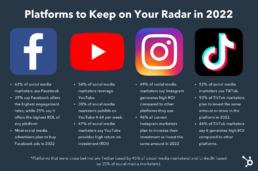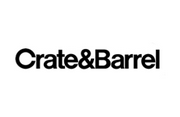The most popular demographics social media marketers target are Millennials (25-40), followed by Gen X (41-56), Gen Z (6-24), and lastly, Baby Boomers (57-75)
There are numerous things to consider while selecting which social media platforms to pursue in 2022. Here’s a quick infographic with some essential information on a few of the platforms you should keep an eye on throughout 2022.
Believe it or not, one of the biggest problems that marketers anticipate facing in 2022 is determining which platform to promote their brand. An excellent place to start is by looking at the audiences you are looking to target.
Age group targeting and breakdown by audience:
- Millennials (ages 25-40) are the #1 group being targeted by social media marketers by far, with 84% of those surveyed saying they target them.
- Gen X (ages 41-56) are targeted by 52% of social media marketers.
- Gen Z (ages 6-24) is targeted by 22% of social media marketers.
- Baby Boomers (ages 57-75) are the least targeted demographic among social media marketers, with just 14% saying they target them.
Can you target two age groups with the same content and find success? First, let’s take a look at the breakdown of video content between the different age groups. While both groups respond positively to video content, the creative message and delivery may need to be tweaked for better results.
Content creation for Millennials and Gen Z
According to recent surveys, Millennials and Gen Z prefer shorter video content that is funny, current, and on-brand. As a result, short-form video platforms; TikTok, YouTube, and Instagram will do well.
Content for Baby Boomers
Baby Boomers prefer a slightly different interaction as they look for informative and educational content. Examples include recent interviews, new podcasts, experts leading discussions, and live streaming videos more recently.
Let’s Look At ROI For Social Media Marketers
This is one of the more difficult challenges marketers face in 2022. With more data at our disposal than ever before, picking out the most important metrics is hard to pinpoint without a set goal.
According to social media marketers, website traffic is the most important overall metric when measuring the ROI of social media campaigns, followed by:
- impressions/views
- clicks
- sales/conversions
- likes/comments
While website traffic is almost always a key indicator of campaign success, there is no one size fits all approach when it comes to social. For example, building brand awareness and engagement may require social media marketers to look beyond webpage traffic and into social metrics that will help social media marketers determine if their social campaigns have the desired effect.
Paying attention to customers on your pages goes a long way to creating a clientele that is dedicated to your brand. This simple action takes little to no time and goes a long way to letting customers know that you care about their concerns and appreciate their positive support. Conversely, failing to pay attention to customer comments or concerns can result in them leaving and going to one of your competitors.
Have Actionable Goals For Your Social Media Campaigns
Below is a shortlist of goals that have measurable results for your campaigns:
- Email list sign-ups
- Contact form inquiries
- Website Visits
- Purchases
- Downloads of a whitepaper or ebook
Set your objectives based on defined activities to obtain the most precise social media ROI numbers possible. Set goals that convert a casual visitor into a lead and, after multiple conversions, an actual customer.
Sort your goals into campaigns to better measure their effects. Think of a simple ad campaign; by looking at the analytics, it is easy to see if the ad campaign paid off. Separating your goal into a campaign will give social media marketers an easier to see if their social media campaign is paying off.
Always Measure Your Goals
Your defined goals are essential, and Google Analytics (GA) offers a great way to see what is working. GA provides insight into social traffic and which channels are driving traffic. From your Google Analytics dashboard, go to Acquisition > Social > Conversions. If you have not yet set up goals, you will be prompted to create one for your campaign tracking. For example, if your goal was to sign up for newsletters, you could track the “thank-you-page” as the goal or indicator that the desired outcome was a success.
Before going all-in on a campaign, it is always good to do some A/B testing. A/B testing is a great way social media marketers can see which social media campaigns are more successful. An example of social A/B testing would be to use social data from one campaign against another to improve effectiveness.
Consider how your target audience prefers to consume different creatives; what are your competitors are up to; and set clear goal-oriented campaigns for your social platforms; there’s no way you can lose in 2022!
Source: Simply Measured Survey, eMarketer US social network users and social media usage; Social Media Marketing Industry Report; Hubspot













